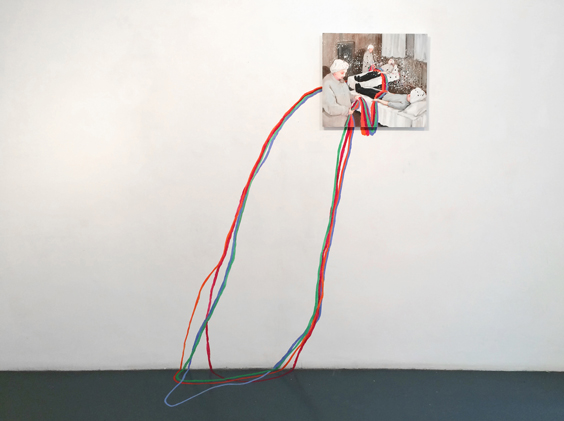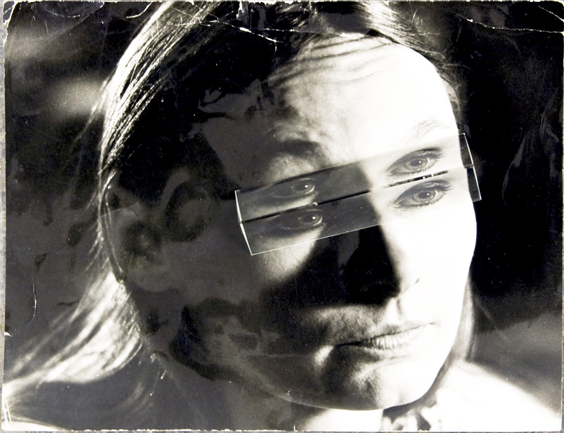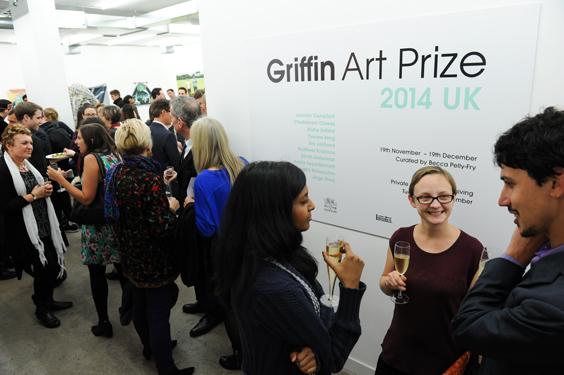
Becca Pelly-Fry. Courtesy Griffin Gallery, London
Becca Pelly-Fry is the director and curator of Griffin Gallery in West London, located in the same building as its parent organisation ColArt International, the company for world renowned art materials brands including Winsor & Newton, Liquitex and Conté à Paris. Since her appointment in 2013, Pelly-Fry has increased Griffin Gallery’s focus on ‘materiality in contemporary art’ and create a space for dialogues through innovative exhibitions and events. In our interview, Pelly-Fry talks about her vision and the gallery’s ongoing commitment to support local, national and international emerging talent.
MKOS: Can you tell us more about the history and mandate of the gallery and how it operates? Is this really the case that Griffin Gallery is that part of ColArt International, a global organisation for art materials, and runs as a privately funded not-for-profit space?
Becca Pelly-Fry [BPF]: Yes, that’s exactly right. The gallery was established in 2012, with the overarching aim of creating a space for display and discussion of contemporary art, a space for artists and ColArt employees to gather. When I took on the Directorship in early 2013, we spent the first few months establishing a five year strategy and a vision for the gallery. At that point we realised that what was going to set us apart from all other gallery spaces in London was our strong connection to the art materials industry – we therefore decided to focus (mainly) on emerging artists with an interest and engagement with materials, and aim to put ourselves at the centre of an ongoing dialogue about materiality in contemporary art.
MKOS: Griffin Gallery has collaborated with several art galleries and art institutions in London and abroad such as Charlie Smith London in Shoeditch, Saatchi Gallery, Free Radical Centre in Melbourne and Trinity Gallery in Tokyo and so on. How did these collaborations come to fruition?
BPF: I am always looking for people to work with who will bring something new to Griffin Gallery, whether that be new artists, new audiences or a new curatorial perspective. There are various avenues for us in seeking partners – as our parent company is a global corporation, it means we have connections in many countries around the world, such as Australia and Japan as you mentioned. This allows us to have a truly global outlook, in (arguably) the most global of all the world’s cities. I am also always looking to work with interesting galleries, curators and organisations in the UK that have a similar ethos to us – Charlie Smith London and Saatchi Gallery are just two that we have worked with recently, but it is an ongoing search.

From ‘Selective Memories’ Lise Stoufflet, Magie, 2014. Oil on wood & oil painted directly on to wall. Courtesy the artist and Griffin Gallery, London
MKOS: For your current exhibition entitled “Selective Memories”, you curated works by students and graduates from l’École Nationale Supérieure des Beaux-Arts in Paris. What was your motivation to curate this specific show?
BPF: This exhibition came about through a four-year partnership with Beaux Arts, established by our ColArt France colleagues. Over the best part of a year I travelled back and forth between London and Paris several times in order to meet the students, tutors and managerial staff of the school and establish the parameters of the show in London. I was immediately impressed with the students there – the standard of their work is universally high, and they were all absolutely open to the idea of collaborating with me to create something that represented them as a coherent group. I am really pleased with the result – the work is very strong, and I think paints a picture of the experience of studying in Paris at one of the very best art schools in the world.
MKOS: Griffin Gallery has organised a few exhibitions for students and recent graduates in the past, surely to give them a platform and kick off their career. What is your advice for aspiring artists?
BPF: In all honesty, all that is really needed is a strong sense of self-belief and a drive to succeed. If you have those things (and a healthy dollop of talent is also helpful!) then nothing can stop you. Don’t ever take no for an answer, and don’t rely on anyone but yourself for your own success. I have the utmost respect for those artists who have created their own destiny, rather than waiting for a gallery or an agent to do it for them. Get out there and make it happen!
MKOS: Your next exhibition is called “West“, a collective show of West London based artists, curated by artistic director of ACAVA Duncan Smith. You have also collaborated with FACK (Forum For Artists in Chelsea and Kensington) in 2013. Although there has always been an active art scene in West London, it seems to have continually been overshadowed by the many galleries in East and South East London, or the West End. Can you describe West London’s art community? Do you see your gallery as a hub for this community?
BPF: Interestingly, West London used to be the most creative part of the city, until only about 30 years ago… The Pre-Raphaelite brotherhood all lived around Notting Hill, Holland Park and Kensington and their influence lasted right up to the 1970s when property prices began their stratospheric increase, driving the artists and creatives to cheaper areas. However, there remains a network of artists and creatives in and around this area, and new galleries are beginning to open up nearby, such as Lacey Contemporary and Space W10. The local authority for Kensington & Chelsea is extremely supportive of arts and culture, too, so there is plenty going on around here. Last year we started a series of walking tours called West Wednesdays, which aimed to connect the dots between Griffin Gallery and the other spaces within walking distance. We see this as the beginning of a resurgence of creativity in West London… Watch this space!

From ‘Two Truths’ Kazuya Tsuji, Polyhedra A, 2012. Courtesy the artist and Griffin Gallery, London
MKOS: Could you also talk about the upcoming exhibition “Two Truths” showcasing six Japanese artists. How did you develop your curatorial concept?
BPF: A key theory that underpins ancient Buddhist philosophy is the doctrine of Two Truths. This doctrine differentiates between two levels of truth: conventional and ultimate (or, relative and absolute). Conventional truth is how we usually see the world; a place full of diverse and distinctive things and beings. Ultimate truth is empty of concrete and inherent characteristics; there are no distinctive things or beings. The artists in this exhibition represent elements of the world around them, conventional truths if you will, perhaps in an attempt to understand the abstract and undefinable; the ultimate truth. Arguably this is the journey of all artists, but with this exhibition I was interested in understanding how the relationship to ‘truth’ might be affected by cultural displacement.
Although Japanese by birth and heritage, three of the exhibiting artists decided early in their careers to move to and ultimately settle in London. The other three are at the beginning of their artistic journeys, having graduated recently, and are still living and working in their home country of Japan. The exhibition explores the similarities and differences in style, methodology and conceptual concerns and asks how much of a role cultural displacement plays in the development of an artist’s practice.
MKOS: What’s next after “Two Truths”? Have you already planned your exhibitions programme for all of 2015?
BPF: Yes – we are in the rather extraordinary position of actually having our programme planned right through to the end of 2016. The remainder of this year includes a new project, the Griffin Gallery Open, which is an open submission opportunity culminating in a salon-style exhibition in mid-summer. I am delighted to have Nigel Hurst, CEO of Saatchi Gallery, and Ian Davenport, Turner Prize-nominated artist, joining me on the selection panel. We then have the first solo show of Griffin Art Prize winner, Chud Clowes, who has been resident in our studio here since early March. Her work is really spectacular, and includes a wide range of media including sculpture, installation, printmaking and performance. Following that, and to coincide with Frieze Art Fair, I am curating a group show of emerging to mid-career artists that explores a meticulous and almost obsessive approach to artistic practice, called Perfectionism (part II). This is the second part of a series of curatorial explorations that began last year at Griffin Gallery, and this time takes a slightly different angle to explore the idea of repetition.
MKOS: What would you like to see happening for your gallery in the next ten years? What is your vision as a director and a curator?
BPF: Put simply, I would like Griffin Gallery to become a firmly established and influential part of the global contemporary art scene. We are looking at doing some off-site projects in the coming years, and ultimately would like to have some presence in other important cities around the world… But one step at a time – we still have plenty to do in London, and I’m really excited about the next couple of years. In a very short time, I have seen the gallery grow and set down roots in what could be considered an already saturated art scene. This tells me that we are on the right track and providing something that no-one else is, so we will continue doing what we do best and hopefully continue to grow our influence at the same time. ◼︎

Griffin Art Prize 2014 Opening reception. Courtesy Griffin Gallery, London
Griffin Gallery
The Studio Building,
21, Evesham Street,
London, W11 4AJ
UK
griffingallery.co.uk
Opening Hours
Monday – Thursday: 10h00 – 17h00
Friday: 10h00 – 16h00
